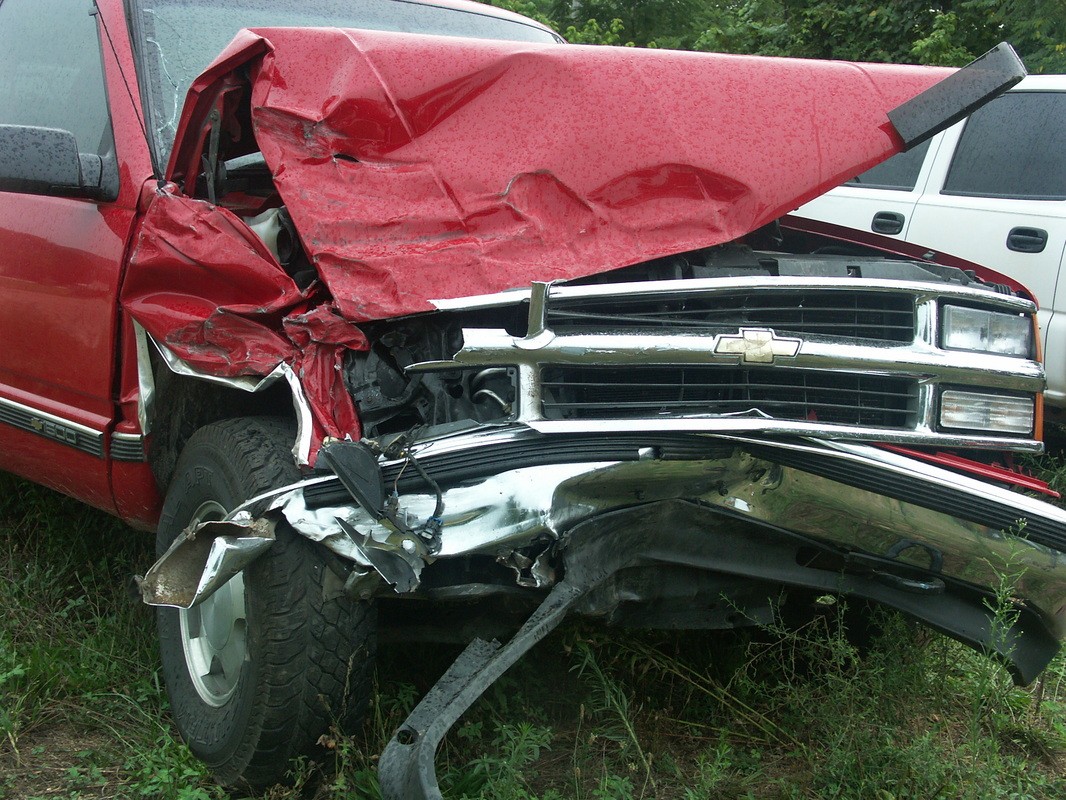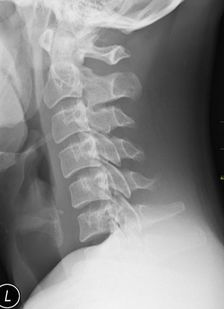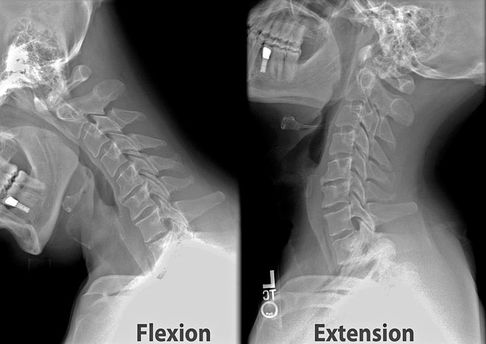WHIPLASH AND THE
REVERSE CERVICAL CURVE
OUR FULL-SIZED SILVERADO AFTER A 2005 RUN-IN WITH A DRUNK
In 2005, we were coming back from a Saturday spent with friends on the CURRENT RIVER. On the way home, a full-sized Chevy Duramax Diesel Crew Cab ran a stop sign at a blind intersection (Hwy M & Old 60), and we T-boned it going about 60 mph. Even though I always fancied myself a “safe” driver, I barely had time to touch my brakes before crunching him. My wife broke her arm and I still have the scars (friction burns) on my forearms from the airbag exploding in my face. Malachi’s head was lopsided for awhile, but all things considered, by the grace of God we came through it relatively unscathed.
NATURE OF THE WHIPLASH INJURY
Most people think that when you are rear ended, your head flies back. Although that is the logical way to think about the injury (it is also how I will talk about it most of the time), it is not technically correct. What actually happens when you are rear-ended is that your body is driven out from under your head. Although there is a great deal of soft tissue stretching that occurs in the soft tissues (LIGAMENTS, TENDONS, MUSCLES, and particularly FASCIA) as your body travels forward at a significantly higher velocity than your head; at some point, these “soft tissues” cannot stretch anymore. This is the first point at which microscopic tissue tearing occurs. Just realize that this is only the beginning of the injury process. The head will eventually catch up to the body, and subsequently overshoot it at an extremely accelerated velocity — all in a tiny fraction of a second.
The head is now accelerating forward faster than your body. When the body comes to a stop (i.e. your vehicle slams into whatever is in front of it), the head will continue to travel forward. This is actually where the term “whiplash” comes from, and where it occurs. It is the same principle of physics that causes the tip of a bullwhip to ‘crack‘ as it breaks the sound barrier. Bullwhips are really cool. Whiplash is not. When this type of ‘whipping‘ motion occurs in the neck, it can cause a great deal of soft tissue damage and subsequent formation of Fibrosis and Scar Tissue (HERE). It can also cause a great deal of occult (hidden) brain and nerve system trauma as well (MTBI) —- a topic for another day.
The picture below comes from Gray’s Anatomy. When the neck is extended backwards (the opposite of flexed forward) we can see a ‘V’ with the Adam’s Apple in the middle. This V is made up of the two large STERNOCLEIDOMASTOID MUSCLES. Although this muscle has a big name, let’s break it down to something that is easier to digest. This muscle is named for its attachment points. Sterno (sternum — breast bone), Cleido (clavicle — collar bone), Mastoid (the large knob of bone directly behind the ear).
TISSUE TEARING
Stop and think about the far-reaching implications of this nasty combination for a moment. The most pain-sensitive tissue in the body cannot be diagnostically imaged with commonly-used technology. Let this sink in for a moment. It’s a recipe for disaster — a potential “PERFECT STORM” of Chronic Pain. This is why standard E.R. procedure for the average whiplash injury involves being sent home with PAIN MEDS, MUSCLE RELAXERS, and ANTI-INFLAMMATORIES after being told, “Thank God Mrs. Jones. Nothing is broken! You’ll be just fine after the soreness wears off in a couple of days.”
But the problem is, Mrs Jones isn’t fine. In fact, her pain might just be starting to kick in (HERE). It’s hard to fathom the incredible numbers of people who are injured in a manner not consistent with our medical community’s ability to accurately diagnose (HERE). We have come to the point in Medicine where if the test says you are sick, you are sick. And unfortunately, if the test says there is nothing wrong with you (HERE), you are fine. The problem is that when you throw Fascial Adhesions into the mix, you not only have a recipe for disaster —- the disaster may be permanent! This is because the known cause of DEGENERATIVE ARTHRITIS is abnormal joint motion over time.
Surround your neck with tissue that looks like the picture below right, and there is no way that your neck will move like God designed it to! Unfortunately, abnormal joint motion causes degeneration, and degeneration causes abnormal joint motion. Repeat ad infinitum. Ladies and gentlemen; start your cycles —- your vicious cycles. Whether or not this cycle was started by an MVA is immaterial at this point (HERE). The process leads to Chronic Pain and despair. Some of you might feel like “DESPAIR” is too strong a word to use in this context. It’s not. In fact, if I could think of a stronger word without running to the thesaurus, I would use it! Those of you who are living inside of this vicious cycle know all too well what I am talking about. Same old tests, same old drugs (the despair is why ANTI-DEPRESSANTS are now routinely prescribed as part of the “BIG FIVE“), same old crappy results.
WHIPLASH AND THE STERNOCLEIDOMASTOID MUSCLE
A person gets whiplashed. Their fascia is torn as their head slams backwards (I told you I would describe this incorrectly). Sooner or later the person begins to have headaches, pain, and a loss of range of motion in their neck. They go to the doctor to find out what is wrong with them. According to all their tests, everything is fine. The problem is that the Fascial Adhesion in the SCM is pulling on their neck 24-7-365. If you realize that Scar Tissue is synonymous with the term “adhesion”, and that adhesives ‘glue’ things together; what do you think a lateral neck x-ray is going to look like if a person has been through this, or any type of head / neck injury — even subtle ones? Think logically here. A restriction (Fascial Adhesion) in the SCM is going to pull the head forward (HERE or HERE).
CURVES DISSIPATE AND REDISTRIBUTE MECHANICAL FORCES
ABNORMAL CERVICAL CURVES
Abnormal curves of the cervical spine (neck) come in two forms. Firstly, you have the loss of cervical lordosis. This is the “Military Neck” you see in the x-ray on the left. Secondly, you have a complete reversal of the lordotic curve (x-ray on the right). These are some of the first steps on the road to Degenerative Arthritis. In the middle pic you can see how flexion and extension are both affected.
THE PLATYSMA MUSCLE
|
For those of you not quite understanding the nature whiplash injury and the NEW MODEL of Tissue Healing and Repair, this picture of the PLATYSMA MUSCLE should help. The Platysma is a large thin muscle that covers the entire front portion of the neck. It is likewise covered in Fascia. This is just one more piece of the puzzle as far as explaining the Chronic Pain so many people struggle with after a whiplash injury — pain that is not explained by diagnostic imaging which is virtually always negative. And like injured SCM Muscles, it helps to explain the abnormal cervical curves as well. As it restricts, it pulls, and as it pulls, the head will come forward.
|
THE CONSEQUENCES OF HAVING THE HEAD TURNED AT IMPACT, OR OF BEING IN A SIDE IMPACT ACCIDENT
|
“A head-turned posture increases facet capsular ligament strain compared to a neutral head posture — a finding consistent with the greater symptom severity and duration observed in whiplash patients who have their head turned at impact.”
|
Forget the fact that the quote above that tells us there is more pain when the head is turned. Let’s attempt to answer the question of why there is more pain. If you have your head turned all the way to the left when you are rear-ended, there will likely be Fascial Tearing of the opposite Sternocleidomastoid Muscle, as well as “jamming” or compacting of the same–side facet joints — the small joints located on either side of the back of the vertebrae. This not only causes Fascial Adhesions and VERTEBRAL SUBLUXATIONS, it leads to FACET SYNDROME and DEGENERATIVE ARTHRITIC CHANGES of the spine as well.
If you want to study this and related issues in more depth, please visit our WHIPLASH INJURIES PAGE. You may be interested in THESE POSTS as well (they will help you understand some of those “Bizarre and Seemingly Unrelated Problems” you have been having since the injury. Oh; and HERE is a list of the main factors that make whiplash injuries worse.
On top of all of this, some of you are not getting better because you have unbridled inflammation running roughshod throughout your body. HERE are some steps to start dealing with this.








